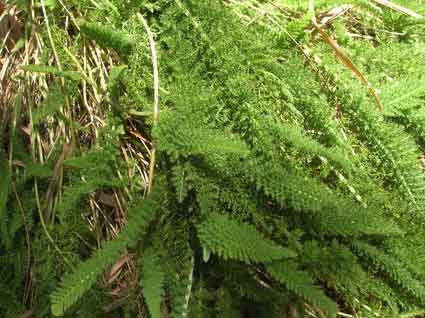
Yarrow / Achillea millefolium

Compositae/Asteraceae
Achillea
millefolium
Achillea, Arrowroot, Bad man’s plaything, Carpenter’s weed, Death flower, Devil’s nettle, Eerie field hops, Geawre, Hundred leafed grass, Knight’s milfoil, Knyghten, Lady’s mantle, Millefoil, Milfoil, Militaris, Military herb, Millefolium, Noble yarrow, Nosebleed, Old Man’s Mustard, Old man’s pepper, Sanguinary, Seven year’s love, Snake’s grass, Soldier’s Wound wort, Stanch Griss, Stanch weed, Tansy, Thousand seal wound wort, Yarroway, Yerw.
Anti-inflammatory Antiseptic, astringent, anti-pyretic,antis[pasmodic,carminative,cholagogue, diaphoretic, diuretic, hypotensive, urinary antiseptic,vasodilator,vulnerary.
Aerial parts.
Up to 1.4% volatile oil , As many as 82 constituents have been identified in the essential oil (composed of up to 51% azulene, borneol, terpineol, camphor, cineol, isoartemesia, ketone, trace of thujone, linalool, sabinene, allo-ocimene, azulene, eugenol, menthol, alpha-pinene, limonene (less than 11%), camphor (18% to 21%) and chamazulene . Sesquiterpene lactones, including alpha-peroxyachifolid , alpha methylene and others, have been determined.) lactones, tannins (3% to 4%), coumarins (± 0.35%), saponins, sterols, a bitter glyco-alkaloid (achilleine), cyanidin, sugars (including dextroses, glucose,sucrose and mannitol). Sesquiterpenoids, achimillic acids A, B, and C. Two guaianolide-peroxides from the plant's blossoms have been found. Other triterpenes and sterols identified in yarrow include beta-sitosterol, alpha-amyrin, stigmasterol, campesterol, cholesterol, beta-amyrin, taraxasterol, and pseudotaraxasterol. Flavonoids present in yarrow include apigenin, artemetin, casticin, luteolin, and rutin. The alkaloids achiceine, achilletin, betaine, betonicine, choline, moschatine, stachydrine, and trigonelline have been found in yarrow. Among the amino acids are alanine, histidine, aspartic acid, glutamic acid, and lysine. Fatty acid constituents include linoleic, myristic, oleic, and palmitic. Other acids found are salicylic, ascorbic, caffeic, folic, and succinic. Other components found in yarrow include polyacetylenes.
As a diaphoretic and anti-pyretic, it is very useful in fevers and it is these factors that have seen it included in the old remedy for colds and flu combined with Elderflowers and Peppermint. It can also help to regulate periods and also stimulates digestion. It helps dilate the peripheral blood vessels and in doing so, helps lower blood pressure. This is due to the alkaloid in the herb. The tannins give yarrow its astringent properties which help in conditions like nosebleeds and internal or external bleeding. It has also been used for piles, particularly if they are bleeding. It also has pain relieving properties (salicylic acid) so can be used for joint pain or painful wounds. An animal study showed that yarrow protects the liver from toxic chemical damage and a trial in India showed yarrow helps hepatitis.
NB. contains compounds which are MAO - A / MAO - B inhibitors therefore should not be used by anyone taking SSRI's or antidepressants.
https://www.theherbalist.com.au/herb_gallery/yarrow
